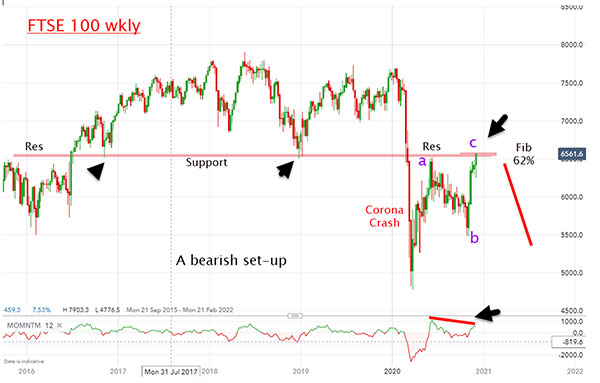Chart of the week: FTSE 100 trades with heavy resistance
Are the pundits right that the vaccine roll-out means normality by Q3?
5th January 2021 14:46
by John Burford from interactive investor
Are the pundits right that the vaccine roll-out means normality by Q3?

This is the time of the year when pundits come out of the woodwork and prognosticate on their outlook for shares and the economy for the new year. And they have been universally confident for gains – some major – and think the vaccine roll-out will practically guarantee a ‘return to normal’ by Q2 or Q3 at the latest.
The rationale for this view is compelling. Savings rates during lockdowns have exploded and this ‘wall of cash’ will move into the ‘cheap’ UK stock market and into a rush of consumer spending from the pent-up demand. When the floodgates are opened as more people receive the vaccine and move out of house arrest, a boom will result.
While that may or may not happen, the ‘wall of money’ theory is utterly false. When someone deploys cash from savings to buy a share, the seller of that share adds the very same amount (less any commissions) to his cash pile. Whatever ‘cash pile’ exists remains constant.
As I have repeatedly shown in these articles, the basic reason why a share price advances is because the buyer and the seller agree that it should and the trade takes place. Nothing more. A bullish sentiment produces rising prices (and vice versa).
- Income prospects for 2021: fund and trust tips
- Top 10 most-popular investment funds: December 2020
- Why reading charts can help you become a better investor
So how did the first day of trading kick off this supposedly bullish outlook? Going into the last day of trading, the FTSE 100 fell off as sterling surged. Despite the ‘wall of money’ supposedly piling into shares yesterday, the FTSE has not yet moved above last Tuesday’s high of 6,678. It remains within the heavy bank of resistance I have identified previously:

Source: interactive investor. Past performance is not a guide to future performance.
So my bearish scenario remains in place. Of course, we could see a little more upside while the residual buying is mopped up, but to me, odds favour a bear trend to come.
- Covid vaccine rally tops your 2020 investing highlights
- Five ways chess can help you buy and sell shares better
- Are you saving enough for retirement? Our calculator can help you find out
Also, it is noteworthy that the vast majority of mainstream commentators are very bullish – I have seen one prominent guru calling for “five figures on the FTSE 100”. That is an advance of 50% from current levels. Hmm.
But remember, when everyone believes something will definitely happen, it rarely does.
For more information about Tramline Traders, or to take a three-week free trial, go to www.tramlinetraders.com.
John Burford is the author of the definitive text on his trading method, Tramline Trading. He is also a freelance contributor and not a direct employee of interactive investor.
These articles are provided for information purposes only. Occasionally, an opinion about whether to buy or sell a specific investment may be provided by third parties. The content is not intended to be a personal recommendation to buy or sell any financial instrument or product, or to adopt any investment strategy as it is not provided based on an assessment of your investing knowledge and experience, your financial situation or your investment objectives. The value of your investments, and the income derived from them, may go down as well as up. You may not get back all the money that you invest. The investments referred to in this article may not be suitable for all investors, and if in doubt, an investor should seek advice from a qualified investment adviser.
Full performance can be found on the company or index summary page on the interactive investor website. Simply click on the company's or index name highlighted in the article.
Disclosure
We use a combination of fundamental and technical analysis in forming our view as to the valuation and prospects of an investment. Where relevant we have set out those particular matters we think are important in the above article, but further detail can be found here.
Please note that our article on this investment should not be considered to be a regular publication.
Details of all recommendations issued by ii during the previous 12-month period can be found here.
ii adheres to a strict code of conduct. Contributors may hold shares or have other interests in companies included in these portfolios, which could create a conflict of interests. Contributors intending to write about any financial instruments in which they have an interest are required to disclose such interest to ii and in the article itself. ii will at all times consider whether such interest impairs the objectivity of the recommendation.
In addition, individuals involved in the production of investment articles are subject to a personal account dealing restriction, which prevents them from placing a transaction in the specified instrument(s) for a period before and for five working days after such publication. This is to avoid personal interests conflicting with the interests of the recipients of those investment articles.